- Successful V8-Powered Reno Racer -
The GP-5: Reborn, Refined, and now, Tragically Lost
NOTE: All our Products, Designs and Services are SUSTAINABLE, ORGANIC, GLUTEN-FREE, CONTAIN NO GMO's, and will not upset anyone's precious FEELINGS or delicate SENSIBILITIES.
25 September 2014
It is with great sadness that I am making this update, because on September 8, 2014, while on a qualifying run at the Reno Air Races, the GP-5 lost a portion of the
right wing and crashed, destroying the aircraft and killing the pilot, my friend Lee Behel.
This article is chronologically organized, so the details on the tragic loss of this aircraft and its owner / pilot are at the bottom of this page.
In the late 1980's, noted aircraft designer George Pereira (US Navy X-28A, Osprey, GP-4, etc.) decided to take a crack at Reno Unlimited air racing. He designed a small, lightweight single-place aircraft (the GP-5) for that purpose.
The original builder of the GP-5 was Gary Childs, who built the airframe to the point that it was on its landing gear, leaving the powerplant, instrumentation, and other finish work remaining to be done. It languished in that state for a few years until George Backovich acquired it and finished the aircraft.
Dave Morss, Reno Racer and test pilot, did the first flights on the aircraft, but soon thereafter, the Reno Air Race Association's (RARA) changed their rules for the Unlimited class to require a minimum weight of 4500 pounds, making the GP-5 ineligible for the Unlimited class. Further, it was not eligible for the Sport class, because those rules required kit airplanes of which a minimum of five had been sold.
(CLICK ON ANY PICTURE BELOW FOR A LARGER IMAGE)
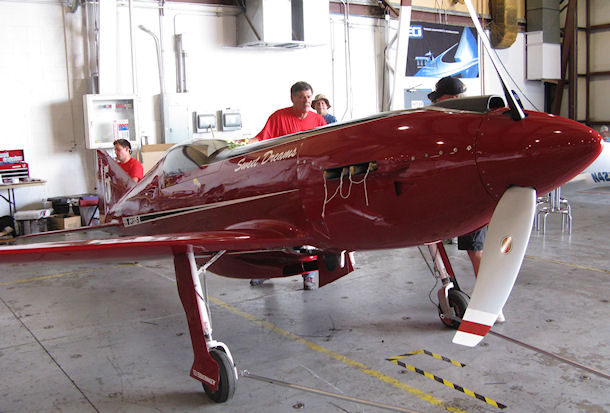
The GP-5 at Reno, 2012
Photo by Jim Jordan
Within a couple of years, the Super Sport class emerged, providing a place for one-off designs to race. However, in 2010, due to a dwindling number of entries in both Super Sport and Sport classes, RARA merged those classes into the current Sport Class. In the new Sport Class, the primary limitation is that the engine must be less than 1000 cubic inches of displacement. There are no restrictions on fuel, boost, ADI, nitrous, etc, and many of the entrants take full advantage of those opportunities. (At least one competitor was overheard referring to Sport-Gold as "Unlimited-Lite".)
In 2010, George Backovich entered the GP-5, named Sweet Dreams (SD), in the Reno Air Races. Lee Behel, retired US Air Force fighter pilot, noted Reno Racer and Reno Check Pilot, was at the controls.
For Reno-2010, Sweet Dreams was powered by a modified Small-Block Chevy (SBC) engine, and a Geschwender Hy-Vo 2" chain drive PSRU. Unfortunately, the engine had so many design errors and engine-building mistakes that it began to fail dramatically during a practice run, and would have sawed itself in half if it had been run about 30 seconds more.
In spite of the limited visibility caused by the coating of engine oil on the canopy, Lee Behel managed to get the airplane back on the ground successfully (captured on this VIDEO).
The failed engine was estimated to be producing 500 hp (at sea level, standard conditions), but there were no dyno data to support that claim. Further, a detailed post-mortem examination of the components and engineering, when compared to engines actually tested at 500+ hp, strongly suggest that it was highly unlikely that it actually produced more than 450 hp.
After the end of the 2010 Reno Air Races, Lee successfully negotiated to become the third owner of the GP-5. Lee had the plane trucked to Mountain Aire Aviation where some serious analysis of the failures and problems began.
In late 2010, Lee contacted me (EPI, Inc.) to consult on various issues with regard to improving the powerplant. EPI was involved in the teardown and inspection of the failed engine, and in the definition and preliminary design of the new engine.
Lee engaged Hasselgren_Engineering,_Inc. to build the new engine for Sweet Dreams. Hasselgren built an ECU-fuel-injected, normally-aspirated 434-CI SBC engine which, after a bit of map tuning, dynoed at just over 625 HP at 5800 rpm (and that was with the short exhaust stacks used on the aircraft - - - A proper set of headers would have added about 50 more HP).
In addition to engine issues, Lee had questions about the chain drive PSRU. I discussed those issues with him, and directed him to the EPI website analysis showing the limitations of Hy-Vo_chain_PSRU's (quite heavy, limited capacity, very limited life).
Lee asked me to provide a new PSRU for the GP-5. I determined that the Mark-15_PSRU was too large for the airframe, but fortunately I had one Mark-9_PSRU available.
We arrived at an agreement about the Mark-9, and began the work to modify it for the higher prop rpm (required a new governor drive gearset) and to incorporate the two upgrades I had devised over the course of approximately 30_of_those_PSRU's being used in V8-powered aircraft, some for over 500 hours. (One owner, who had put more than 700 hours on his, described his Mark-9 as "bulletproof".)
As a part of EPI's support of this project, I examined the airframe in detail at Mountain Aire Aviation. I offered the opinion that the existing engine mount appeared to be quite-a-bit under-engineered to sustain the loadings applied by a heavy, high-powered engine spinning a high-rpm metal prop at the airspeeds and g-loads imposed by a 350 mph lap around Reno.
Rather than rely on observations and guesswork, I built a 3D-CAD model of the existing mount and subjected it to a detailed FEA study. That study, detailed in a 20-page report to the Lee and to Mountain Aire Aviation, showed that under the loads applied during a 350+ mph race lap (a combination of torque, gyroscopic moment, vertical and horizontal g-loads and gust loading plus FAR safety factors), the mount structure was (a) seriously overstressed and (b) far too flexible. The study also revealed that the firewall attach brackets for the engine mount structure were gravely overstressed by those same loads.
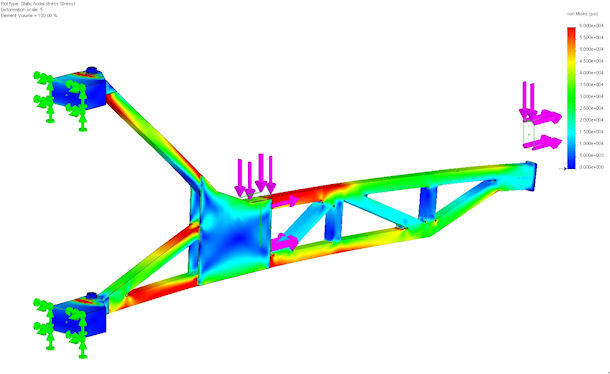
FEA of the Original Mount
Based on the results of that study, EPI designed a new engine mount structure and a reinforcement strategy for the firewall attach brackets. The new mount and reinforced brackets had acceptable stress levels under the same loads as were used to analyze the original mount.
In order to fit into the very compact engine compartment envelope, the new mount structure looked similar in shape to the original, but it is substantially stronger and almost 3 times stiffer than the existing mount, which minimizes the probability of whirl_mode_problems. Mountain Aire engaged an aircraft-certified welder to construct the new mount and to accomplish the firewall bracket reinforcements.
The test flight program for the remodeled GP-5 began in early 2012 at Hollister, CA. On March 11, the aircraft suffered a failure of the landing gear structure in-flight (high aerodynamic loading on poorly-welded components), causing a gear collapse on landing. That destroyed the specially-designed Hartzell race prop, badly damaged one wing of the airframe, and lots of other parts. Thankfully, the pilot (Lee Behel) was not injured.
George Pereira himself took over the rebuild of the wing structure. Hasselgren Engineering went completely through the engine and addressed a few minor problems. EPI did a complete teardown and inspection of the PSRU, and found one very serious problem (to be detailed later) resulting from the severe loads imposed by the destruction of the propeller. We were able to repair the problem caused by the crash and get the Mark 9 PSRU ready for the intense test flight program which had to be completed in order to compete at Reno-2012.
The crew at Mountain Aire Aviation did an amazing job of getting the aircraft back together and supporting the the test flight program, which was completed just in time for the 2012 Reno Air Races.
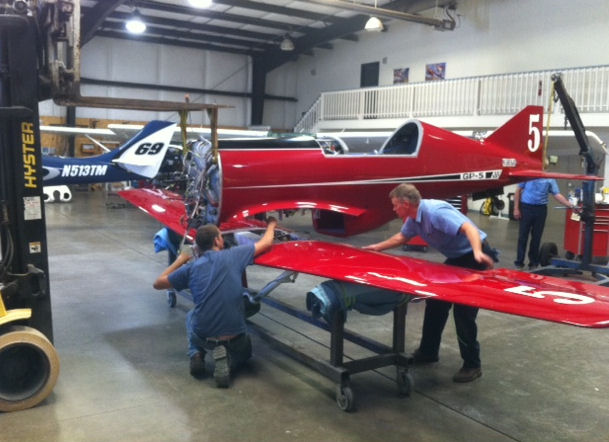
Installing the Rebuilt Wing at Mountain Aire
Photo by Lee Behel
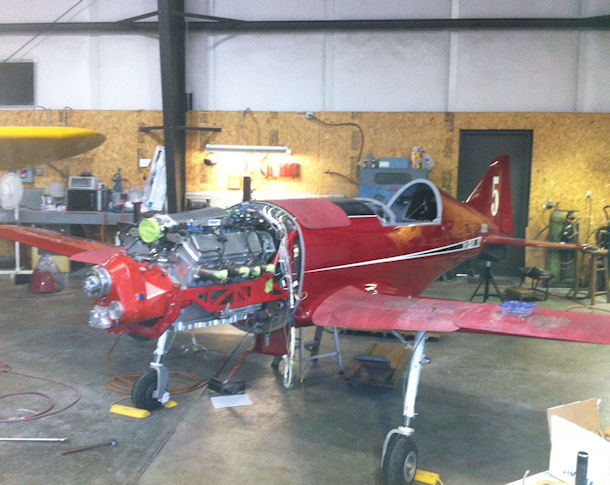
Hasselgren Engine and EPI Mark-9 PSRU Installed at Mountain Aire
Photo by Lee Behel
Sweet Dreams competed successfully in the 2012 Reno Air Races Sport-Gold Class. It qualified at 363.233 mph, finished third in two of the heat races, fourth in the other heat race, and finished fourth in the Sport-Gold race at 359.573 mph.
Post-race analysis of the data collected by the onboard full spectrum data acquisition system shows that the race speed would have been somewhat better had it not been for an overheating problem, which prompted the pilot to reduce power mid-race as a precautionary measure. The overheating issue showed up when the engine RPM stayed above 5300 RPM for an extended period. The temperature of the oil exiting the gearbox would, under those conditions, begin to rise toward the limiting oil temperature. At full throttle below 5300 RPM (actually closer to peak torque), the oil temperature was stable and well within the operating range.
Post-Reno testing revealed that at higher engine and propshaft speeds, the oil inside the gearbox was being centrifugally "roped" away from the scavenge pickup, and the Mark-9 oil scavenge pump was not able to extract the oil from the gearbox. Prior to this installation, the Mark-9 had never, to our knowledge, been operated at an input speed in excess of 5100 RPM, so this was a new issue.
The team solved the problem by adding a supplmental scavenge pump (which is only used above 5000 RPM) and by revising the gearbox venting. Since those changes, the GP-5 can be flown at maximum power and maximum RPM for extended periods without and gearbox oil temperature issues.
As described above, the Hasselgren engine in Sweet Dreams is a normally aspirated 434-CI V8 engine, highly-modified but based on SBC dimensions. At present, it produces just a bit over 625 HP on the dyno, corrected to sea-level, standard conditions.
However, the mean airport elevation at Reno-Stead is 5050 ft. above sea level, and the aircraft generally race at about 5100 ft. altitude. On a day at Reno with an OAT of 85°F, the standard pressure at 5100 ft. (29.92 altimeter setting) is 24.80 in-hg, the density altitiude is 7865 feet and the density ratio is approximately 0.79.
With those atmospheric conditions, there is an additional ram boost of 3.5"hg available at 350 mph TAS. Andy Chiavetta designed and built a submerged engine inlet scoop for Sweet Dreams (visible in the picture below). That scoop recovers about 2"hg of the available 3.5"hg ram boost, so at 350 MPH under the atmospheric conditions stated above, the engine runs with a MAP approximately 2"hg above ambient. Assuming a 20°F temperature rise in the plenum, the density ratio in the plenum under those conditions is 0.823, allowing about 515 HP max. However, the reduced ambient gives a bit better exhaust scavenging (unquantified on this installation). Taking those variables into account, under those conditions the engine in Sweet Dreams is capable of approximately 525-530 HP max.
In view of the facts that (a) both the LaVelle Glasair-III (winner) and the Farnsworth Lancair Legacy (3rd place) are both heavily turbocharged, and (b) the Thunder Mustang (2nd place) runs with a generous boost of nitrous oxide, there is a definite challenge to be met.
Engineering and development work are now in progress to assure that Sweet Dreams will be very competitive at Reno-2013.
For those readers who are not intimately familiar with the competition levels at the Reno Air Races, the top six finishers in the Sport-Gold race were FASTER than the winner of the Unlimited-Bronze race (330.507). Further, the winner of the Sport-Gold race (Jeff LaVelle at 393.552) would have finished a VERY close second to the winner in the Unlimited-Silver race at 394.520, (the Unlimited-Silver second place speed was 391.907), and Sweet Dreams would have finished ahead of the fourth place Unlimited-Silver plane (an F7F-3 Tigercat at 359.200).
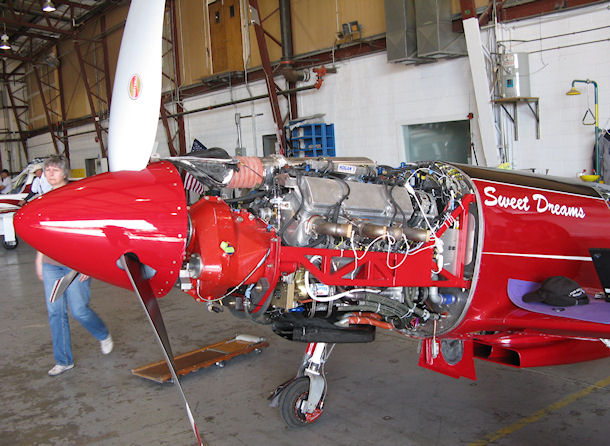
Sweet Dreams at Reno-2012
Photo by Jim Jordan
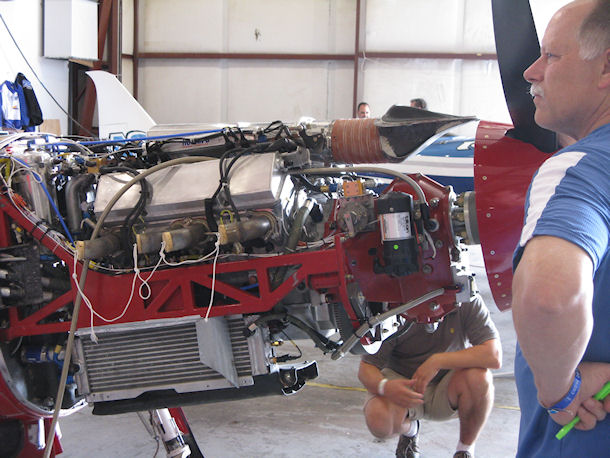
Sweet Dreams at Reno-2012
Photo by Jim Jordan
In the two following pictures, the GP-5 is shown on display at Oshkosh-2013.
The first picture shows the racer in front of the Reno Air Races display tent, and the second one shows the GP-5 flying in formation with a fine example of the GP-4 aircraft.
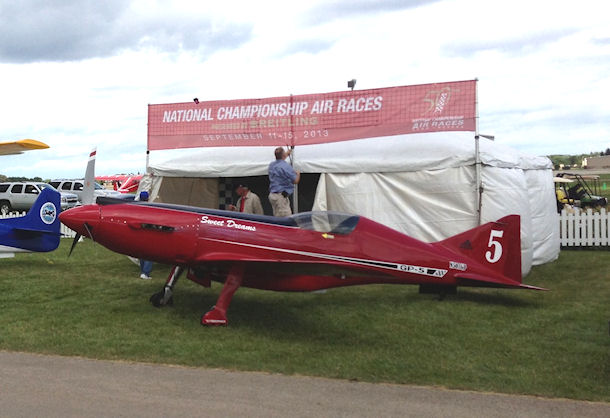
Sweet Dreams at Oshkosh-2013
Photo by Lee Behel
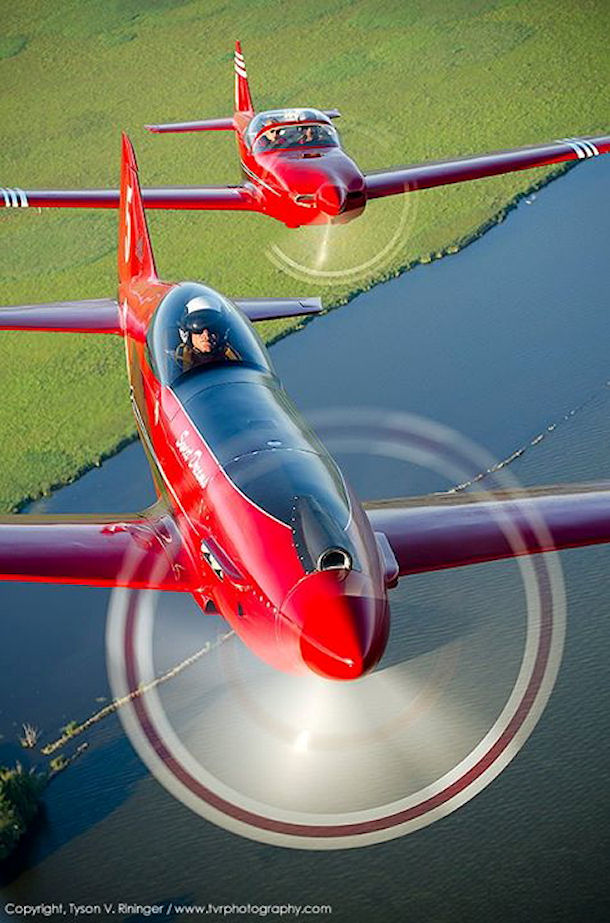
Sweet Dreams in formation with a GP-4, Oshkosh-2013
Photo by Tyson V. Rininger, TVR Photography
The careful observer will have noticed that in the picture above, the submerged inlet scoop has been replaced by an external scoop in an attempt to recapture more of the dynamic pressure. Whereas the previous (submerged) scoop recaptured about 57% of the available dynamic pressure, the new, raised scoop recaptures nearly 86%. That improvement, plus the solution of the gearbox oil scavenge capacity problem, as well as some aerodynamic refinements made in the past year, should produce some interesting improvements in Reno lap times for 2013.
UPDATE: 14 APRIL 2014 ----- Lee Behel set three new records in Class C-1b today with the GP-5. The first was the 3000 meter time-to-climb, with a time of 2:00 minutes even, breaking the previous record of 2:20 set by Bruce Bohannon in 1999. The second was the speed over a 3 kilometer course at 377.6 MPH, breaking the previous record of 356.1 set by Jon Sharp in 1998 in the Nemesis-NXT. The third was the speed over a 15 kilometer course at 378.7 MPH, breaking the previous record of 358.8 MPH set by MayCay Beeler in 1989.
Congratulations, Lee !
UPDATE: 8 September 2014 ----- Today the aviation community suffered the loss of an amazing pilot, competitor, innovator and mentor, Lee Behel.
While on a qualifying run for the Sport Class race on a remote section of the Reno Air Races course at Reno-Stead airport, a section of the right wing failed and departed the aircraft, causing the plane to roll to the right and descend into the ground. Based on data from previous speed runs, it is likely that the aircraft was travelling nearly 400 miles per hour, and probably no more than 100 feet above ground level. The wreckage was strewn over a debris field of nearly 4000 feet. Reportedly, all the major pieces and fragments were recovered, including the engine control unit and monitoring system.
In the course of investigating this accident, the NTSB reconstructed the debris-field jigsaw puzzle in an effort to determine the cause of the structural failure. Here is an extract from the full NTSB report regarding that failure:
The National Transportation Safety Board determines the probable cause(s) of this accident as follows:
The failure of the right wing under normal race loads due to an improper repair of the right wing spar that reduced its structural strength following a previous
landing accident.
The outboard portion of right wing was reconstructed using the pieces found in the initial debris path. The reconstruction revealed that the right wing
forward box spar fractured at the inboard end of a splice repair to the right wing spar in an area where the upper and lower spar caps transitioned from a singular
rectangular cross section to two smaller rectangular finger sections. The scarf joints on each finger were also fractured through the adhesive with no evidence of
wood grain failure on either side of the scarf areas. Typically, failure of a bonded wood joint should occur within the wood grain adjacent to the bond area if
the adhesive has been properly prepared and applied. The accident airplane was involved in a landing accident about 30 months before the accident that substantially
damaged the right wing.
The wing was reportedly removed from the airplane and repaired by the original designer. No information existed on the repair, no logbook entry was made for the
repair, and no requirement for documenting any repairs to the airplane existed in the operating limitations. It is likely that the right wing spar repair was not
done in accordance with the approved methods in the Federal Aviation Administration Advisory Circular (AC) 43.13-1B, thus the strength of the wing in the area of
the repair was reduced. Aircraft maintenance records contained entries related to cracking in the right and left wing lower skins. Personnel working on the airplane
during the air races reported that the cracking was located in the area aft of the forward spar near the main landing gear trunnions, which was well inboard of the
area where the right wing failed.
The investigation determined that these cracks did not contribute to the accident. The morning of the accident, the pilot attempted a practice flight; however,
he pulled off the course shortly after entering the course due to an excessive vibration. The race crew determined that the pilot had encountered the rev-limiting
function on the engine control unit. The pilot reported to another pilot that he thought the airplane was going to shake itself apart during the event.
It is possible that the airframe vibrations induced by the engine could have affected the spar repair on the right wing. Further, the airplane’s high speed,
high g-loads, and left bank produced wing loads sufficient to fail the right wing forward spar at the location of a previous repair. Even though the airplane was
likely not being operated outside the original design envelope at the time of the right wing failure, the reduced strength of the repair led to the wing’s failure.
HERE is a link to the full NTSB report of the accident.
Lee was a retired Air Force fighter pilot, a former champion at the Reno National Championship Air Races, one of the founders of the Sport Class in the air races, and president of that class. Lee was not only a client of EPI, he was a personal friend. We extend our sympathy and compassionate thoughts to his family and to his other friends and colleagues, and hope he is with The Lord.

